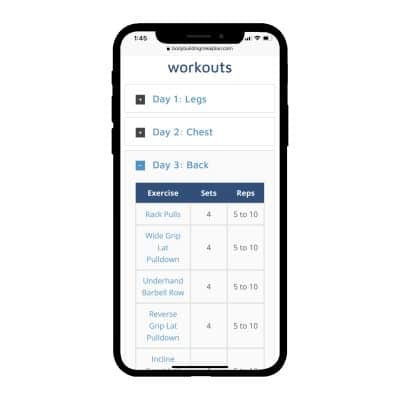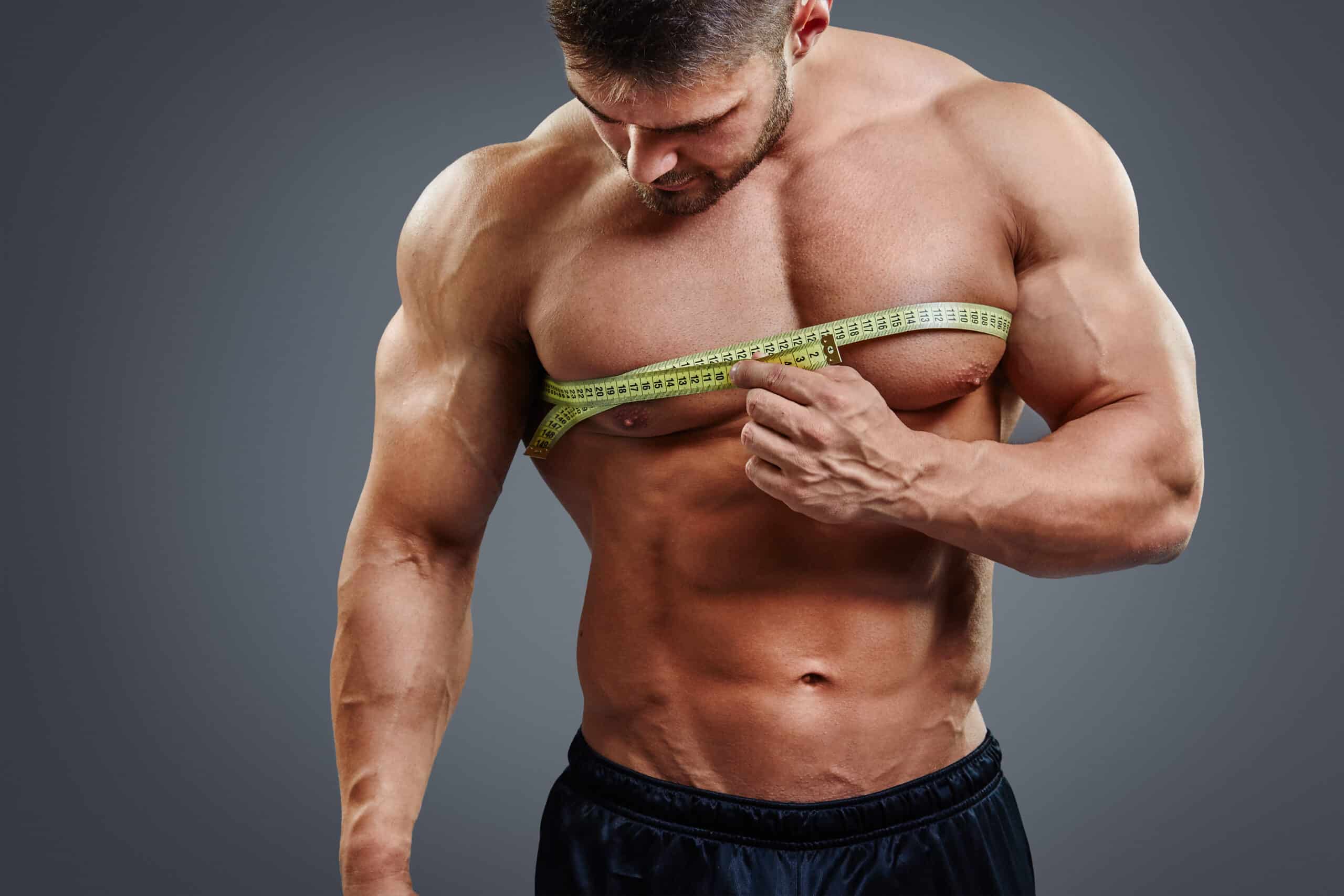Rack Pull vs Deadlift
Differences, Benefits, and When to Use Each Exercise
By: Jeremy Fox, CNC, CPT – Published: Mar 25, 2021
Anyone who’s stepped foot in a gym is familiar with the deadlift. It’s one of the fundamental exercises across all weight lifting disciplines.
And you may have also seen or heard of an exercise called rack pulls – a popular deadlift variation. But you might not know the subtle differences between them.
In this article, I’m going to break down a rack pull vs deadlift in terms of the muscles they work and their benefits. So you’ll know when and how to use them in your workout routine.
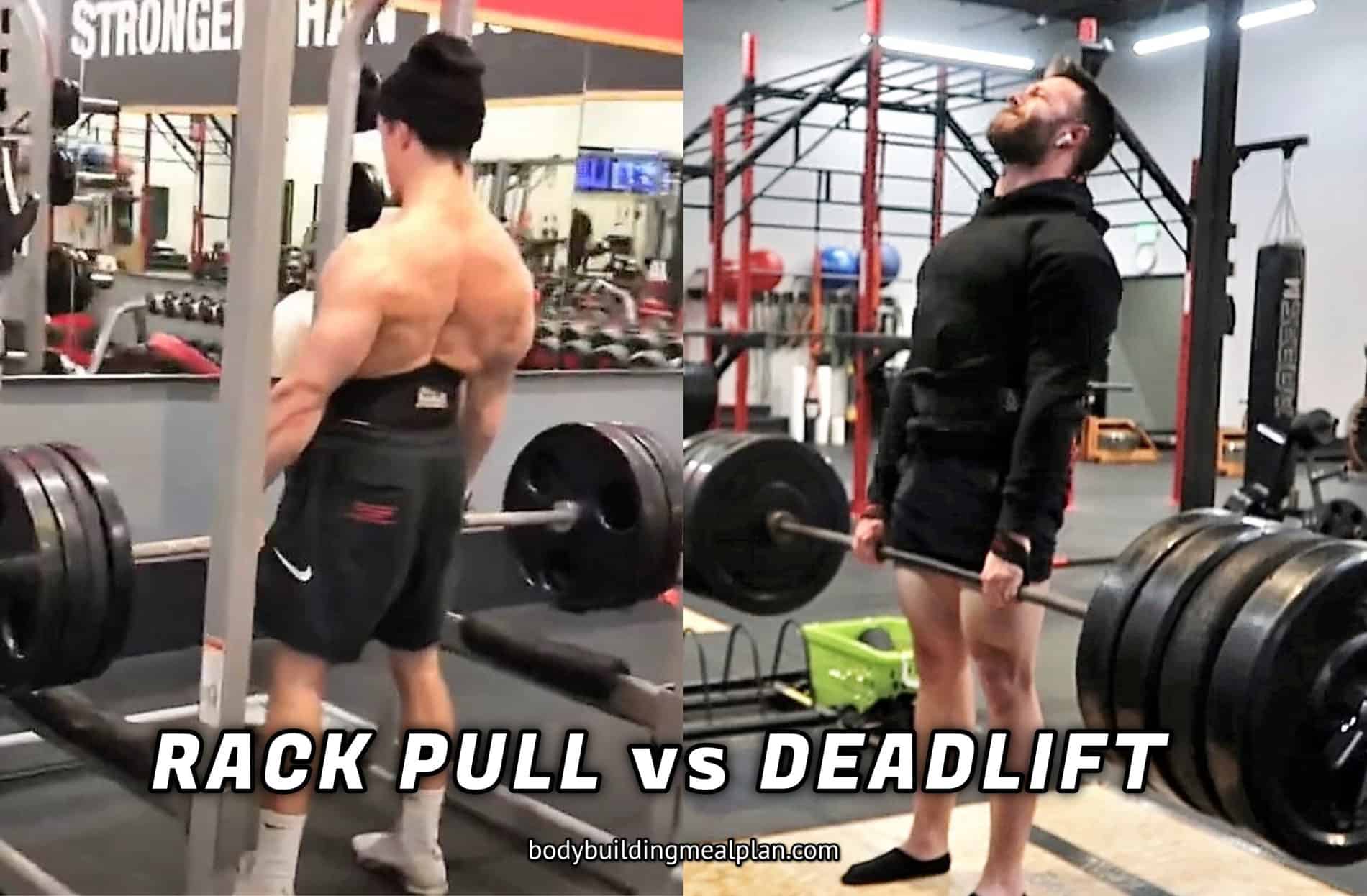
Rack pulls and deadlifts are very similar movements that work multiple muscle groups in the posterior chain. Those are the muscles that make up the back of the legs and spine.
Both exercises are what’s called a hip hinge movement. And they are each great for developing overall strength and building up the muscles of your back. But there are some differences between the rack pull vs deadlift.
Rack Pull vs Deadlift: What’s The Difference?
Rack pulls are a variation of the deadlift exercise in which the barbell is placed on a rack at about knee height as opposed to resting on the floor. By starting with the bar off the ground, rack pulls have a shorter range of motion than a conventional deadlift.
This higher starting position means you can usually lift heavier weight than a regular deadlift. But it also slightly changes the muscles worked during the exercise.
Rack Pull Muscles Worked
Due to the shorter range of motion, rack pulls don’t put as much load on the hamstrings or lower back. Most of the load is lifted using the glutes and spinal erectors.
At the top of the movement, your lats and traps pull the bar back and up as you stand erect. And your forearm flexors fire to maintain your grip on the bar.
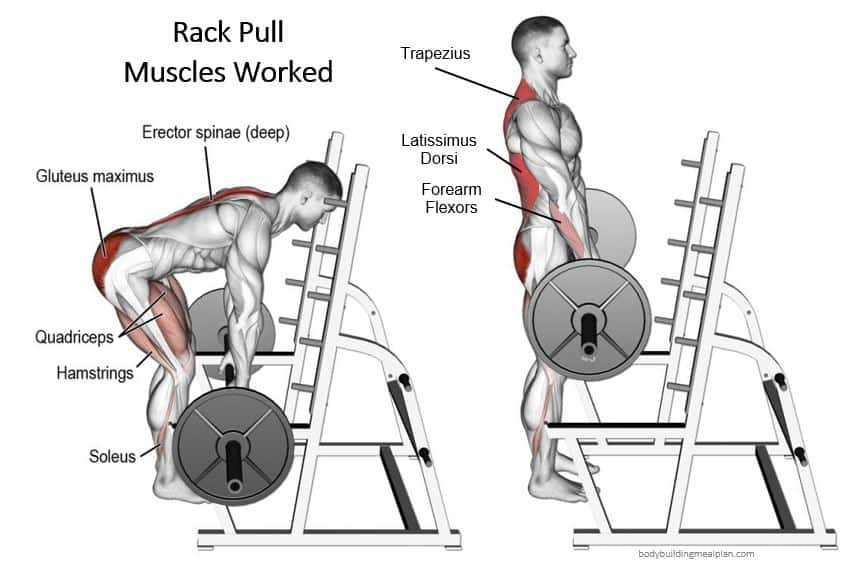
Rack pulls primarily work the glutes, spinal erectors, lats, and upper traps. Secondary muscles include the calves, hamstrings, and forearms.
Deadlift Muscles Worked
With the bar on or near the floor, your upper body is bent farther forward at the beginning of a deadlift compared to a rack pull. This means your hamstrings, glutes, and lower back take a lot of the load at the start of the movement.
Once the bar passes your knees, the muscles of the back take over. And the rest of the movement is the same as a rack pull.
Overall, deadlifts work more muscles than rack pulls, particularly in the lower body. This is why they are so great for building muscle and strength.
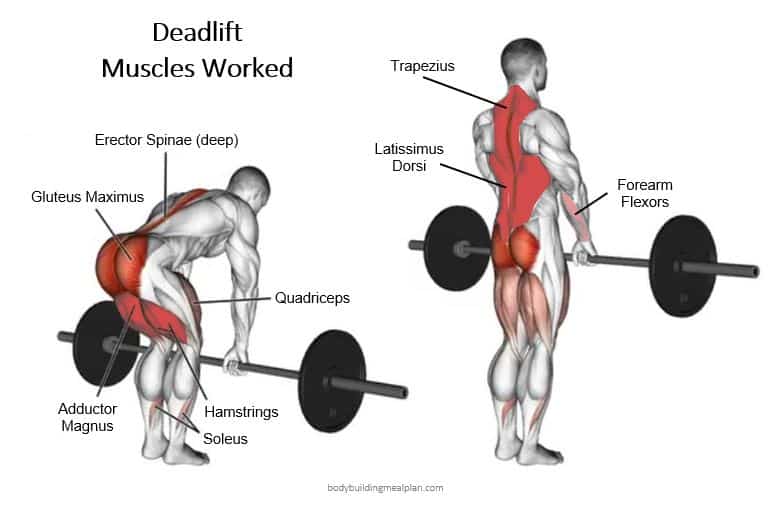
Deadlifts primarily work the hamstrings, glutes, spinal erectors, lats, and upper traps. Secondary muscles include the calves, quads, and forearms.
Rack Pull vs Deadlift Benefits
Rack pulls and deadlifts certainly have a lot in common. But the difference in range of motion and muscles worked means that each has pros and cons.
Benefits of Rack Pulls
- Not as much strain on your lower back
- Enables you to work around pains & strains in your lower body
- You can lift heavier loads
- Great for building muscles in your upper back
- Helps you improve deadlift lockout
Benefits of Deadlifts
- Probably the best exercise for total strength and muscle mass
- Works more hamstrings and glutes along with upper back
- Doesn’t require a heavy-duty adjustable rack or blocks
How To Do Rack Pulls
Before you begin, set the catch rails or safety pins of a power rack so that the bar sits about 1 inch below your knees. You can also put some padding down to reduce the noise. It can get quite loud when the bar hits the metal rack!
Next, perform a few warm-up sets to get the blood flowing into your muscles and get a feel for the movement. Some back stretcing while warming up is also a good idea for injury prevention.
Once you’re warmed up you can begin the working sets. Grasp the bar with hands about shoulder-width apart. You can use a mixed grip (one overhand, one underhand). But for really heavy loads, I recommend an overhand grip with wrist straps to reduce strain on your bicep.
To begin the lift, start with the bar touching your shins (or knees). Your back should be straight and your butt down. Now drive through your legs and push your hips forward as you pull the bar up. At the top of the movement, pull your shoulders back.
Then lower the bar under control back down to the rack. Pause for a second or two before beginning the next rep.
My YouTube channel has dozens of videos showing you how to do a variety of bodybuilding exercises. You’ll learn how to target and build specific muscle groups in 90 seconds or less. Click HERE to subscribe, or click on the button below!
How To Do Deadlifts
Before you begin, make sure you spend some time stretching your hamstrings, glutes, and back. Then start with some warm-up sets using light weights to get the blood flowing and ease into the movement.
After you’ve warmed up, you can begin the working sets. As with rack pulls, grasp the bar with hands about shoulder-width apart and use wrist straps if your grip strength fails before your other muscles.
To begin, roll the bar back towards your shins and dip your butt down. Your back should be straight or have a slight arch. Keep your chest out and look straight ahead.
For deadlifts, you really want to focus on driving through your legs to get the bar off the ground. Then push your hips forward as the bar moves up your shins and past your knees. At the top of the movement, pull your shoulders back and lock out your knees and hips.
Now drop the bar down to the floor in a controlled fashion. Pause for a second or two before beginning the next rep. This prevents you from taking advantage of the bounce off the floor and ensures you’re working through a greater range of motion.
Custom Nutrition & Workout Plan
Get a personalized meal plan designed to fit your body and lifestyle. Including a custom workout routine built around your schedule and fitness goals.
All this for just $24.99! Click here to choose your plan.
Rack Pull vs Deadlift Q&A
So far we’ve covered the basic differences between rack pulls and deadlifts. Now I’ll answer some common questions related to these two exercises.
Are Rack Pulls Better Than Deadlifts?
For overloading the upper back muscles, you could argue that rack pulls are superior to deadlifts since you can pull heavier loads. They’re also useful when working around certain injuries or strains. For example, when I had a strained glute, I could do rack pulls but not deadlifts.
On the other hand, deadlifts are a better exercise if you’re looking to build overall strength and size because they incorporate more hamstrings, glutes, and low back. Plus there’s just something primal about lifting a heavy weight straight off the floor.
Can Rack Pulls Replace Deadlifts?
While rack pulls are not exactly interchangeable with deadlifts, they can be used as a substitute in certain situations. As mentioned above, you can replace deadlifts with rack pulls if you’re unable to lift the bar from the ground.
Or you can alternate between rack pulls and deadlifts when one lift starts to plateau. But if you’re healthy and able, you should not use rack pulls as a way to avoid deadlifts.
Are Block Pulls The Same As Rack Pulls?
Block pulls are essentially the same thing as rack pulls except they use a different method for elevating the bar. While rack pulls use a power rack or squat rack to support the bar, block pulls use a sturdy object to support the weight plates.
Both exercises are a raised variation of the deadlift. Although block pulls may raise the bar as little as 1 inch from the floor.

An example of sturdy blocks used to elevate the bar for a block pull variation.
How High Should The Bar Be For Rack Pulls?
Most often, the bar for rack pulls is set just below the knees. This is the point in the deadlift movement where the load transitions from hamstrings to back. So it’s the best height to maximize the engagement of your back muscles.
You could go a little lower if you want to involve some hamstrings. But you shouldn’t go above the knee because then the range of motion is reduced to almost nothing.
Can You Do Rack Pulls On a Smith Machine?
Yes, you can do rack pulls on a smith machine if you don’t have access to a power rack. But this will change the exercise to some extent due to the guide rails.
On one hand, the guide rails inhibit the natural path of the bar from front to back. On the other hand, the rails reduce the need to stabilize the bar, and that can put more load on the major muscles.
What Is A Deficit Deadlift?
A deficit deadlift is another popular variation of the deadlift and it’s essentially the opposite of rack pulls. Instead of moving the bar up, you move your feet up. This is accomplished by standing on a sturdy platform or plate – usually 1 to 4 inches high.
With deficit deadlifts, you’re effectively increasing the range of motion by having a deeper starting point. This requires much more activation from the hamstrings and glutes. And it’s a good way to improve the first stage of your deadlift.
Are Rack Pulls Dangerous?
Rack pulls are generally safe as long as you use proper form. And the rack itself prevents you from being hurt if you drop the weight.
However, this is an exercise where the weights can get exceedingly heavy. So there is potential to over-exert yourself and strain your back or neck. Just make sure you gradually build up the load and avoid lifting a weight you can’t handle.
In addition, there is a greater risk of overtraining with heavy total-body exercises like rack pulls and deadlifts due to the huge strain on your nervous system. For that reason, make sure you give yourself enough time to recover between workouts.
How Often Should You Do Rack Pulls Or Deadlifts?
For injury prevention and to avoid overtraining, you should allow at least 72 hours of recovery between workouts involving rack pulls or deadlifts. Studies show this is the amount of time required for your nervous system to recover from the heavy load.
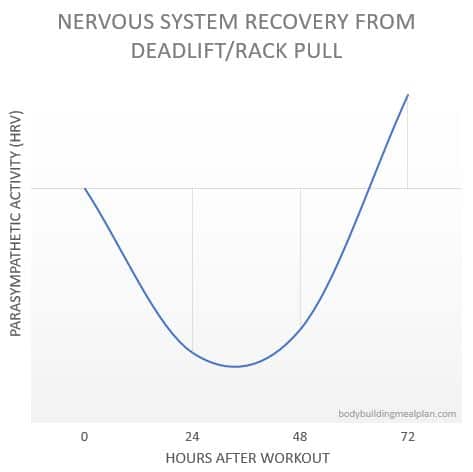
Effect of heavy compound movements on nervous system recovery (predicted heart rate variability [HRV] response). Adapted from Chen et al.1
Rack Pull vs Deadlift Key Takeaways
Conclusion
At the end of the day, the battle of rack pull vs deadlift isn’t won or lost. Each exercise has a role in helping you reach your training goals.
Deadlifts are the king of exercises for building strength and mass. While rack pulls can build your back and improve your strength in the top half of the deadlift.
Therefore, rack pulls and deadlifts can be rotated in and out of your routine to build upon one another. For more exercise and fitness tips, be sure to check out my related articles below.

